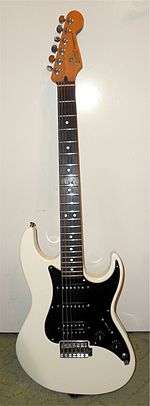Fender Prodigy
| Fender Prodigy | |
|---|---|
 A rare white Fender Prodigy with a Humbucker pickup at the bridge C1991. This example has had the whammy bar removed and is missing a knob on the pickup switch. | |
| Manufacturer | Fender |
| Period | 1991–1993 |
| Construction | |
| Body type | Solid |
| Neck joint | Bolt-on |
| Woods | |
| Body | Alder |
| Neck | Maple |
| Fretboard | Maple or Rosewood |
| Hardware | |
| Bridge | Synchronized Tremolo or Kahler Locking Tremolo |
| Pickup(s) | 2 single-coils and 1 bridge position humbucker |
| Colors available | |
| Black, White, Metallic Blue, Metallic Red, Sunburst | |
The Fender Prodigy is a discontinued model of electric guitar produced by Fender from 1991 to 1993. It is one of Fender's attempts to compete with the superstrat-style guitars produced by Ibanez, Jackson/Charvel, Carvin Corporation and Yamaha. Since the Prodigy series was discontinued after about two and half years of production without a clear reason, it is considered one of Fender's rare models because of its limited production. Fender also produced a Prodigy bass based on the Precision Bass Plus Deluxe featuring a P/J pickup layout, 2-band active circuitry and a "fine-tuner" Schaller Elite bridge assembly.
The Prodigy series featured two single coil pickups and one humbucker at bridge position. The body shape was similar to that of the Stratocaster; however, it featured an offset body, sharper body edges, and a smaller headstock. The Prodigy was relatively different from Fender's HM Stratocaster since it used Leo Fender's classic Synchronized tremolo system. The Prodigy II was introduced in 1992 with the Kahler locking tremolo & nut system instead; this model also featured Fender/Schaller tuners and black hardware.
The Fender Prodigy's headstock is imprinted with "Made in U.S.A." and Tony Bacon's book 50 Years of Fender mentions the Prodigy as being "among the first Fender guitars to receive attention at the company's new factory in Ensenada, Mexico".[1] However, current sources at Fender attribute the majority of manufacture to the Corona, California plant.
-

A rare black 1992 Fender Prodigy in new condition.
References
- ↑ 50 years of Fender by Tony Bacon, Paul Day, page 100.